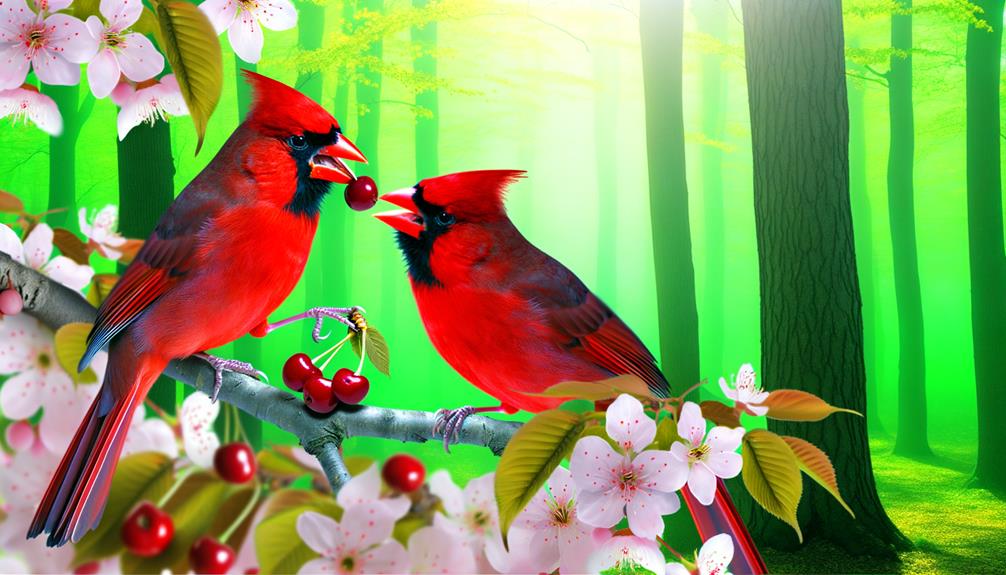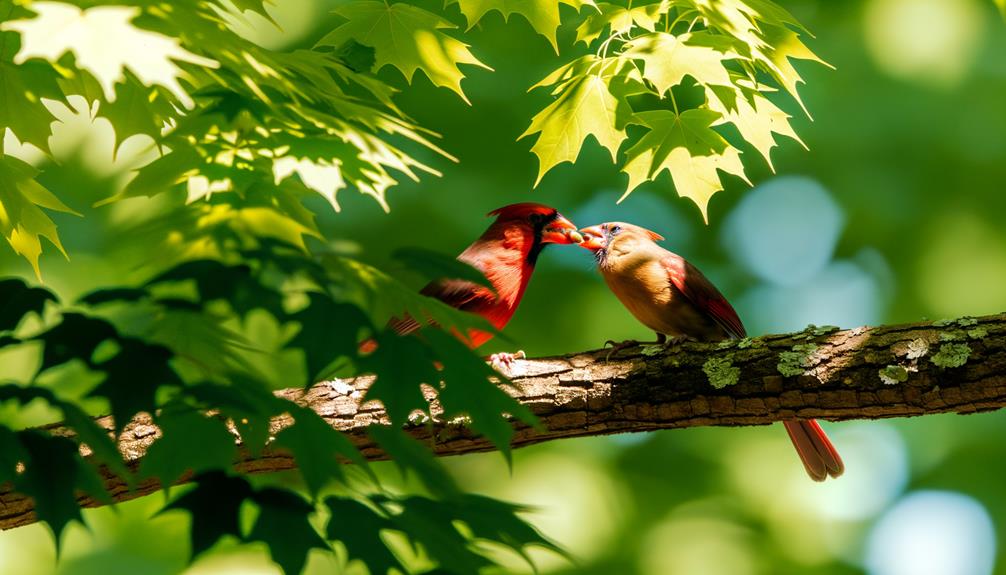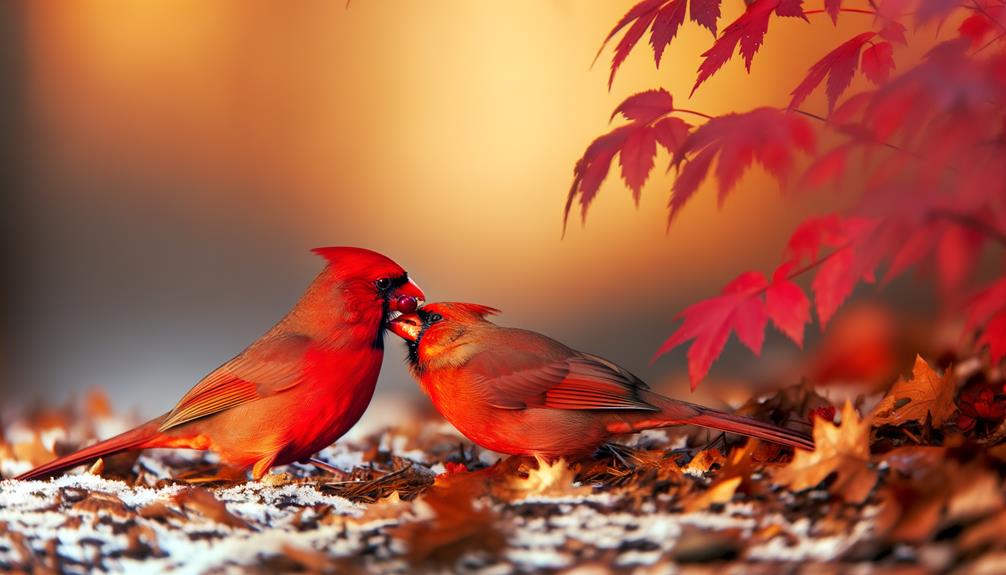How Do Cardinals Feed Each Other in Your Backyard?
Yes, cardinals do feed each other, particularly during courtship and parenting. Male cardinals often feed females to strengthen pair bonds and guarantee their nourishment, especially during the breeding season.
This behavior, known as mate-feeding, also showcases the male's suitability and health as a mate. Additionally, male cardinals assist in feeding their chicks, notably contributing to the offspring's survival and development.
Such interactions foster trust and solidify family group bonds, which are crucial for their social structure and reproductive success. Exploring these behaviors can provide deeper insights into cardinal life and relationships.

Key Takeaways
- Male cardinals feed females during courtship to strengthen pair bonds and ensure reproductive success.
- Parent cardinals feed their chicks to ensure their survival and growth.
- Mate-feeding by males indicates their health and suitability as partners.
- Feeding behaviors reinforce family bonds and cooperation within the cardinal group.
- Cardinals' feeding rituals include mutual preening, which fosters trust and solidarity.
Cardinal Feeding Behavior

Cardinals frequently display fascinating feeding behaviors that reveal intricate social interactions and survival strategies.
You'll notice that these birds prefer to forage on the ground, favoring seeds, grains, and fruits. They aren't just ground feeders, though; cardinals also explore bushes and low tree branches for sustenance.
Watch closely, and you'll see them use their strong, conical beaks to crack open hard seeds, demonstrating their adaptability. They're highly territorial, often guarding their feeding grounds against intruders.
During winter, when food is scarce, cardinals may form small groups to locate food more efficiently. By observing their feeding habits, you'll gain insight into their complex behaviors and the ways they navigate their environment to ensure their survival.
Mate-Feeding Explained
Beyond their individual feeding habits, you might observe a particularly intriguing behavior known as mate-feeding, where one bird offers food directly to its partner.
This behavior isn't just a random act; it's a purposeful and significant interaction. When a male cardinal feeds a female, it often serves to strengthen their bond and ensure the female remains well-nourished, particularly during breeding seasons.
This act can involve the male carefully selecting and delivering food items such as seeds or insects. By engaging in mate-feeding, cardinals demonstrate a cooperative dynamic that enhances their chances of reproductive success.
Observing this behavior can provide valuable insights into the social structures and bonding mechanisms within bird species, emphasizing their intricate and adaptive nature.
Courtship Feeding Rituals

In the domain of avian courtship, the ritual of feeding a mate plays a critical role in establishing and reinforcing pair bonds among cardinal couples. You'll observe that male cardinals often engage in this behavior, offering seeds or insects to the female.
This act not only demonstrates the male's ability to provide but also strengthens their emotional connection. Research indicates that courtship feeding can be an indicator of the male's health and suitability as a mate.
Additionally, this ritual helps synchronize the reproductive cycles of both partners, ensuring that they're physically and emotionally prepared for the breeding season. It's a fascinating example of how intricate and essential these behaviors are in the avian life cycle.
Parent-Offspring Feeding
Observing a cardinal family, you'll notice that parent-offspring feeding is an essential behavior ensuring the survival and growth of the chicks. The adult cardinals diligently gather food and return to the nest to feed their young.
This behavior involves several key steps:
- Foraging: Parents search for insects, seeds, and fruits, which are crucial for the chicks' nutrition.
- Feeding: Adults transfer food directly into the chicks' open mouths, ensuring each gets enough to eat.
- Monitoring: Parents continuously check on the chicks' development and adjust their feeding strategies accordingly.
Bond Strengthening

While feeding their young is necessary, cardinals also engage in behaviors that strengthen bonds between mates and within their family group.
You'll notice that male cardinals often feed their female partners during courtship and nesting periods. This behavior, known as mate feeding, reinforces pair bonds and guarantees cooperation in raising offspring.
Additionally, mutual preening, where cardinals groom each other's feathers, plays a significant role in bond strengthening. Such interactions foster trust and solidarity, vital for survival and reproductive success.
Nutritional Benefits
When cardinals feed each other, they share important nutrients that are vital for their health. This practice guarantees both birds receive a balanced diet, thereby boosting their energy levels.
Essential Nutrients Shared
Cardinals share important nutrients such as proteins, fats, and vitamins when they feed each other, ensuring both birds maintain peak health and energy levels. This nutrient exchange is significant for several reasons:
- Protein Intake: Proteins are vital for muscle development and repair, enabling cardinals to stay strong and active.
- Healthy Fats: Fats provide a dense energy source, which is important for sustaining their high metabolic rates.
- Vitamins: Vitamins such as A, D, and E support immune function, bone health, and cellular repair.
Energy Boosting Practices
Many energy-boosting practices observed in cardinal feeding behaviors directly enhance their nutritional advantages, supporting sustained strength and resilience.
When cardinals feed each other, they're not just sharing food; they're optimizing energy intake. You'll notice that parent cardinals select nutrient-rich foods like insects, which are high in protein and fats, essential for growth and energy. They also consume seeds, which provide essential carbohydrates for immediate energy.
By transferring these nutrients through feeding, cardinals ensure each other's metabolic needs are met efficiently. This practice is particularly important during breeding seasons when energy demands peak.
You can appreciate how these behaviors support their overall well-being, enabling them to thrive in dynamic environments.
Seasonal Variations

Significantly, seasonal fluctuations greatly influence the frequency and context in which cardinals engage in the behavior of feeding each other. You'll notice notable variations throughout the year.
During spring and early summer, males often feed females as part of courtship rituals. This behavior strengthens pair bonds and ensures females receive sufficient nutrition during egg-laying.
In contrast, parental feeding peaks in late summer into early fall, as both parents feed fledglings to secure their survival.
- Spring/Early Summer: Males feed females to establish and maintain pair bonds.
- Late Summer/Early Fall: Both parents feed fledglings to support their growth.
- Winter: Feeding each other is less frequent, as cardinals focus on foraging for themselves due to scarce resources.
These seasonal behaviors highlight the adaptability and survival strategies of cardinals.
Observational Studies
Through meticulous observational studies, researchers have documented various instances of cardinals engaging in the behavior of feeding each other, providing valuable insights into their social dynamics and survival strategies.
You'll find that both male and female cardinals participate in this behavior, often during courtship and nesting periods. They exchange food as a means of strengthening pair bonds and ensuring the female has enough resources during egg-laying and incubation.
Scientists have carefully recorded these interactions, noting specific patterns like the types of food exchanged and the frequency of feedings. These detailed observations are essential for understanding how cardinals navigate their environment and optimize their reproductive success, ultimately contributing to their overall resilience and adaptability.
Common Misconceptions

Despite the clear observational evidence, several common misconceptions persist about the behavior of cardinals feeding each other. You might've heard that cardinals only feed their young. In reality, adult cardinals also engage in this behavior, particularly during courtship.
Another misconception is that only male cardinals feed the females. Scientific studies have shown that females also feed males, although less frequently.
Here are three common misconceptions:
- Only parents feed young: Adult cardinals feed each other too.
- Only males feed females: Females occasionally feed males as well.
- Feeding indicates nesting: This behavior can also indicate courtship.
Understanding these behaviors allows you to appreciate the complexity of cardinal interactions beyond mere parental duties. Don't let these misconceptions limit your perspective.
Encouraging Natural Behavior
You can encourage cardinals' natural behavior by providing a habitat that supports nutritional mutual assistance. This involves adults feeding each other and their young. This behavior also strengthens pair bonds, enhancing their social structure.
Additionally, observing fledgling care techniques can offer insights into the development and survival strategies of juvenile cardinals.
Nutritional Mutual Assistance
Encouraging cardinals' natural behavior of nutritional mutual assistance involves observing their instinctual tendencies to feed each other, particularly during mating and parenting periods. You'll notice these behaviors strengthen as the breeding season approaches.
To facilitate this behavior, you can:
- Offer a reliable food source: Provide seeds, fruits, and insects to guarantee they've ample nutrition.
- Establish a bird-friendly environment: Plant native shrubs and trees to offer shelter and natural food.
- Reduce disturbances: Minimize human and predator interference to allow cardinals to interact freely.
Strengthening Pair Bonds
Observing cardinals as they engage in mutual feeding can provide insight into how these behaviors strengthen pair bonds and contribute to their overall reproductive success.
When cardinals feed each other, it's not just about nutrition; it's a powerful bonding activity. This ritual reinforces their partnership and fosters cooperative parenting.
Mutual feeding increases synchronization between mates, enhancing communication and coordination. By participating in this behavior, you're witnessing a natural method for improving reproductive outcomes.
This bonding process also helps them defend their territory more effectively, as a united pair is stronger against intruders. Encouraging such behavior in a natural habitat can promote healthier, more resilient cardinal populations, thereby supporting ecological balance and biodiversity.
Fledgling Care Techniques
Many factors contribute to successful fledgling care, but fostering natural behavior in young cardinals is crucial for their development and survival. To promote this, you should focus on:
- Providing Appropriate Food:
Offer a diet rich in insects and seeds, imitating what adult cardinals feed their young. Avoid human food as it can disrupt their innate diet.
- Minimizing Human Interaction:
Limit handling and exposure to humans. This helps fledglings develop necessary caution and survival skills in the wild.
- Creating a Natural Habitat:
Guarantee their environment includes native plants and secure nesting areas. This encourages natural foraging and shelter-seeking behaviors.
Conclusion
You've seen how cardinals feed each other to strengthen bonds, especially during courtship and parenting. Imagine observing a male cardinal delicately passing a seed to his mate, reinforcing their connection and ensuring their offspring's survival.
This behavior isn't just endearing; it's an essential survival strategy. Recognizing these patterns can help you encourage natural feeding behaviors in your garden, fostering a thriving ecosystem.
Understanding cardinal feeding habits enriches our appreciation of these vibrant birds and their intricate social structures.






